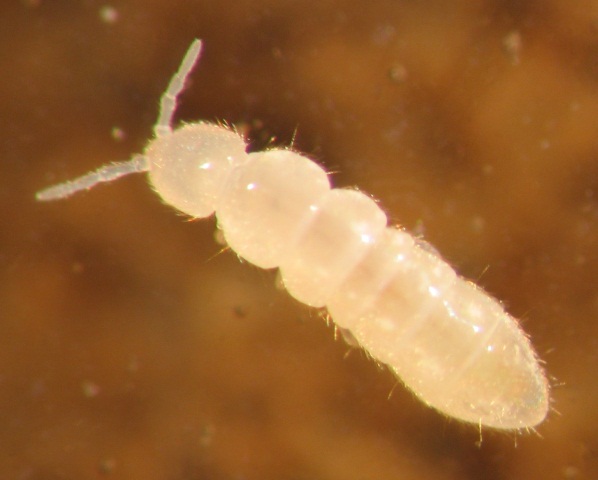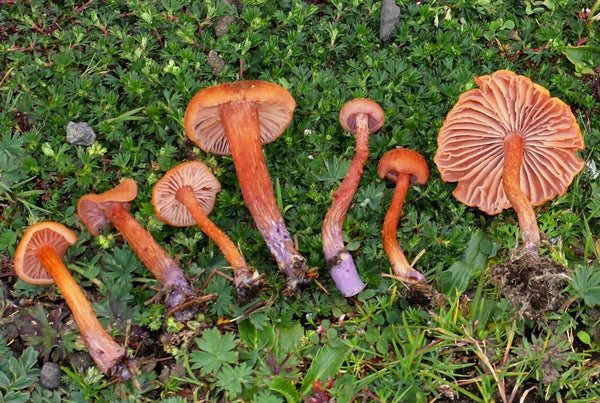This article was published in Scientific American’s former blog network and reflects the views of the author, not necessarily those of Scientific American
Springtails are little leaping insects far too small to catch the notice of the naked human eye. But with a little magnification, some of them turn out to be adorable beyond belief. Take this clip from the BBC’s David Attenborough classic Life in the Undergrowth:
On supporting science journalism
If you're enjoying this article, consider supporting our award-winning journalism by subscribing. By purchasing a subscription you are helping to ensure the future of impactful stories about the discoveries and ideas shaping our world today.
Life In The Undergrowth – Springtail Dance (music by David Poore) from David Poore on Vimeo.
So it is with some dismay that I must relate a little story I came across when researching my last post. Because these little guys are the victims.
And here are their vicious killers.
“2012-09-22 Laccaria bicolor (Maire) P.D. Orton 270921 crop” by Alan Rockefeller (Alan Rockefeller) at Mushroom Observer, a source for mycological images. You can contact this user here.
derivative work: Ak ccm – This file was derived from: 2012-09-22 Laccaria bicolor (Maire) P.D. Orton 270921.jpg. Licensed under CC BY-SA 3.0 via Wikimedia Commons.
This is Laccaria bicolor, a common and edible forest mushroom. The mushrooms you see above are only one tiny and ephemeral reproductive portion of a mycorrhizal fungal body that also surrounds tree roots and sends out filaments into the soil in search of water, minerals — and apparently, springtails.
I wrote last time about the amazing connective powers mycorrhizae also confer — to my surprise — on their plant partners. They enable trees to communicate and share resources below ground, even if those trees are from radically different species.
But I also discovered that these root fungi can confer some darker powers on their plant hosts. This was discovered by accident by John Klironomos and Miranda Hat at the University of Guelph in Canada about 15 years ago.
They were working with a springtail called Folsomia candida, a distinctly less-cute cousin of the cover-model species the BBC chose to film.

“Folsomia candida – Soil Fauna Diversity” by Cristina Menta – Cristina Menta (2012). Soil Fauna Diversity – Function, Soil Degradation, Biological Indices, Soil Restoration, Biodiversity Conservation and Utilization in a Diverse World, Dr. Gbolagade Akeem Lameed (Ed.), ISBN: 978-953-51-0719-4, InTech, DOI: 10.5772/51091. Available from: http://www.intechopen.com/books/biodiversity-conservation-and-utilization-in-a-diverse-world/soil-fauna-diversity-function-soil-degradation-biological-indices-soil-restoration. Licensed under CC BY 3.0 via Wikimedia Commons.
Little soil dwellers like springtails and mites eat fungi, and during a “routine” feeding experiment the scientists discovered that less than 5% of the springtails in one dish had survived their fungus grazing experience. That fungus was Laccaria bicolor.
Incriminatingly, all the dead springtails had fungus fibers riddling their little corpses. Instead of springtails eating the fungus, the reverse appeared to have happened.
By contrast, the other test cultures were little springtail Club Meds, where all the insects were not only still alive, they had “actively reproduced”.
 Red=alive sprintails, blue=dead springtails. Lb= Laccaria bicolor, Cg=Cenococcum geophilum (another ectomycorrhizal fungus), Ch= Cladosporium herbarum, Ep= Epicoccum purpurascens, control=no fungus. Fig. 1 from lironomos and Hart 2001. Click image for source.
Red=alive sprintails, blue=dead springtails. Lb= Laccaria bicolor, Cg=Cenococcum geophilum (another ectomycorrhizal fungus), Ch= Cladosporium herbarum, Ep= Epicoccum purpurascens, control=no fungus. Fig. 1 from lironomos and Hart 2001. Click image for source.
When they repeated the experiment and watched closely, they were able to recreate the carnage. By staining springtails with a dye that indicates aliveness, they found several were somewhat gruesomely still alive even though they could no longer move. They hypothesized the helpful mycorrhizal fungus that helps pine trees grow is also a sinister fungus that produces a toxin that paralyzes springtails so the fungus can take its sweet time about eating them.
Next, they wanted to find out what happened to the nitrogen from springtail bodies. Nitrogen, as you’ll recall, is perhaps the most precious currency in the forest because it is so difficult to extract from the air and so few creatures can do it, but every organism on Earth needs it to make protein. They labeled their springtails with radioactive (and hence traceable) nitrogen-15 and placed them — some alive, some pre-killed — in a culture with an eastern white pine (Pinus strobus) infected with L. bicolor, carefully ensuring only fungi, not roots, had access to the springtails. They they watched for two months.

“Pinus strobus Syvania” by Joseph O’Brien, USDA Forest Service –
This image is Image Number 1397002 at Forestry Images, a source for forest health, natural resources and silviculture images operated by The Bugwood Network at the University of Georgia and the USDA Forest Service.. Licensed under CC BY 3.0 us via Wikimedia Commons.
Lo, up to 25% of the nitrogen in plant tissue ultimately came from springtails, whether provided alive or dead. And the plants grew better too when fertilized by hapless springtails, weighing more at the end of the experiment than their control counterparts. Less than 10% of springtails placed at the experiment at the beginning were alive at the end … an average of just 47 wily survivors out of the 500-strong starting team.
“Predatory plants” as traditionally defined have been found in small groups in nitrogen-starved environments — typically swamps, but sometimes also deserts. Think Venus fly-trap, sundew, and pitcher plant. And there can be no question, however you look at it, that those cute pink mushrooms at the top of this post are “predatory fungi”. But are the pine trees in this experiment “predatory plants”? In my judgment, distinctly un-sexy Eastern white pine — a common tree in the vast northern forests of this planet — might just belong on that sexy list of deadly plants too, at least with an asterisk.
This example also raises the possibility that trees harnessing fungi to harvest nitrogen from tiny forest animals might be much more common — and ecologically significant — than we ever understood or believed, especially if Laccaria bicolor and Pinus strobus are not an isolated case. Laccaria, in particular, is known to partner with many tree species. A cute little springtail on the lookout for a bit of nookie and a bite of fungus may have just as much to fear from the placid, graceful tree towering overhead as from the crafty spider waiting patiently nearby.
Reference
Klironomos J.N. & Hart M.M. Food-web dynamics. Animal nitrogen swap for plant carbon., Nature, PMID: http://www.ncbi.nlm.nih.gov/pubmed/11287942

